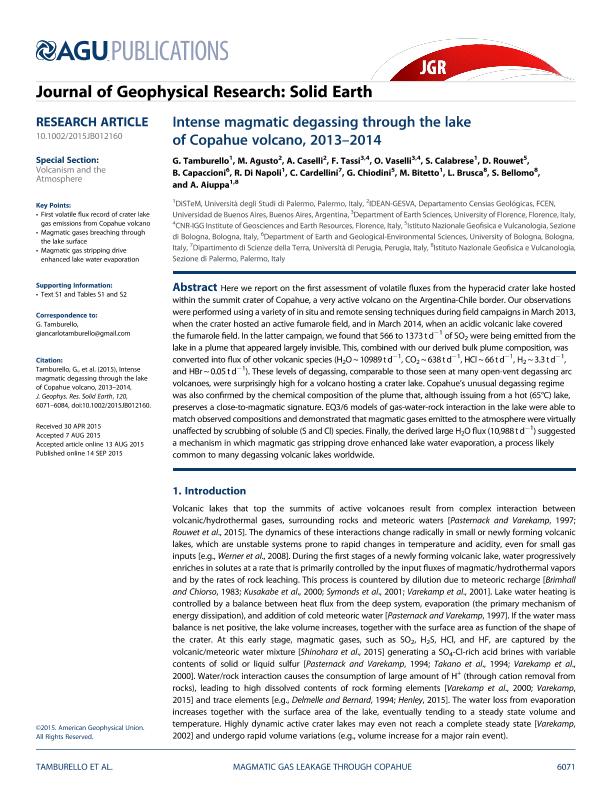Mostrar el registro sencillo del ítem
dc.contributor.author
Tamburello, G.
dc.contributor.author
Caselli, Alberto Tomás

dc.contributor.author
Tassi, F.
dc.contributor.author
Vaselli, O.
dc.contributor.author
Calabrese, S.
dc.contributor.author
Rouwet, D.
dc.contributor.author
Capaccioni, B.
dc.contributor.author
Di Napoli, R.
dc.contributor.author
Cardellini, C.
dc.contributor.author
Chiodini, G.
dc.contributor.author
Bitetto, M.
dc.contributor.author
Brusca, L.
dc.contributor.author
Bellomo, S.
dc.contributor.author
Aiuppa, A.
dc.date.available
2019-10-02T20:27:54Z
dc.date.issued
2015-09
dc.identifier.citation
Tamburello, G.; Caselli, Alberto Tomás; Tassi, F.; Vaselli, O.; Calabrese, S.; et al.; Intense magmatic degassing through the lake of Copahue volcano, 2013-2014; Blackwell Publishing Ltd; Journal of Geophysical Research: Solid Earth; 120; 9; 9-2015; 6071-6084
dc.identifier.issn
2169-9356
dc.identifier.uri
http://hdl.handle.net/11336/85059
dc.description.abstract
Here we report on the first assessment of volatile fluxes from the hyperacid crater lake hosted within the summit crater of Copahue, a very active volcano on the Argentina-Chile border. Our observations were performed using a variety of in situ and remote sensing techniques during field campaigns in March 2013, when the crater hosted an active fumarole field, and in March 2014, when an acidic volcanic lake covered the fumarole field. In the latter campaign, we found that 566 to 1373 t d -1 of SO 2 were being emitted from the lake in a plume that appeared largely invisible. This, combined with our derived bulk plume composition, was converted into flux of other volcanic species (H 2 O ~ 10989 t d -1 , CO 2 ~ 638 t d -1 , HCl ~ 66 t d -1 , H 2 ~ 3.3 t d -1 , and HBr ~ 0.05 t d -1 ). These levels of degassing, comparable to those seen at many open-vent degassing arc volcanoes, were surprisingly high for a volcano hosting a crater lake. Copahue's unusual degassing regime was also confirmed by the chemical composition of the plume that, although issuing from a hot (65°C) lake, preserves a close-to-magmatic signature. EQ3/6 models of gas-water-rock interaction in the lake were able to match observed compositions and demonstrated that magmatic gases emitted to the atmosphere were virtually unaffected by scrubbing of soluble (S and Cl) species. Finally, the derived large H 2 O flux (10,988 t d -1 ) suggested a mechanism in which magmatic gas stripping drove enhanced lake water evaporation, a process likely common to many degassing volcanic lakes worldwide. Key Points First volatile flux record of crater lake gas emissions from Copahue volcano Magmatic gases breaching through the lake surface Magmatic gas stripping drive enhanced lake water evaporation
dc.format
application/pdf
dc.language.iso
eng
dc.publisher
Blackwell Publishing Ltd

dc.rights
info:eu-repo/semantics/openAccess
dc.rights.uri
https://creativecommons.org/licenses/by-nc-sa/2.5/ar/
dc.subject
COPAHUE
dc.subject
DEGASSING
dc.subject
VOLCANIC LAKE
dc.subject.classification
Vulcanología

dc.subject.classification
Ciencias de la Tierra y relacionadas con el Medio Ambiente

dc.subject.classification
CIENCIAS NATURALES Y EXACTAS

dc.title
Intense magmatic degassing through the lake of Copahue volcano, 2013-2014
dc.type
info:eu-repo/semantics/article
dc.type
info:ar-repo/semantics/artículo
dc.type
info:eu-repo/semantics/publishedVersion
dc.date.updated
2019-09-20T13:43:13Z
dc.journal.volume
120
dc.journal.number
9
dc.journal.pagination
6071-6084
dc.journal.pais
Estados Unidos

dc.journal.ciudad
Washington
dc.description.fil
Fil: Tamburello, G.. Università degli Studi di Palermo; Italia
dc.description.fil
Fil: Caselli, Alberto Tomás. Consejo Nacional de Investigaciones Científicas y Técnicas. Oficina de Coordinación Administrativa Ciudad Universitaria. Instituto de Estudios Andinos "Don Pablo Groeber". Universidad de Buenos Aires. Facultad de Ciencias Exactas y Naturales. Instituto de Estudios Andinos "Don Pablo Groeber"; Argentina
dc.description.fil
Fil: Tassi, F.. Università degli Studi di Firenze; Italia
dc.description.fil
Fil: Vaselli, O.. Università degli Studi di Firenze; Italia
dc.description.fil
Fil: Calabrese, S.. Università degli Studi di Palermo; Italia
dc.description.fil
Fil: Rouwet, D.. Istituto Nazionale di Geofisica e Vulcanologia; Italia
dc.description.fil
Fil: Capaccioni, B.. Universidad de Bologna; Italia
dc.description.fil
Fil: Di Napoli, R.. Università degli Studi di Palermo; Italia
dc.description.fil
Fil: Cardellini, C.. Università di Perugia; Italia
dc.description.fil
Fil: Chiodini, G.. Istituto Nazionale di Geofisica e Vulcanologia; Italia
dc.description.fil
Fil: Bitetto, M.. Università degli Studi di Palermo; Italia
dc.description.fil
Fil: Brusca, L.. Istituto Nazionale Geofisica e Vulcanologia; Italia
dc.description.fil
Fil: Bellomo, S.. Istituto Nazionale Geofisica e Vulcanologia; Italia
dc.description.fil
Fil: Aiuppa, A.. Istituto Nazionale Geofisica e Vulcanologia; Italia
dc.journal.title
Journal of Geophysical Research: Solid Earth

dc.relation.alternativeid
info:eu-repo/semantics/altIdentifier/doi/http://dx.doi.org/10.1002/2015JB012160
dc.relation.alternativeid
info:eu-repo/semantics/altIdentifier/url/https://agupubs.onlinelibrary.wiley.com/doi/full/10.1002/2015JB012160
Archivos asociados
